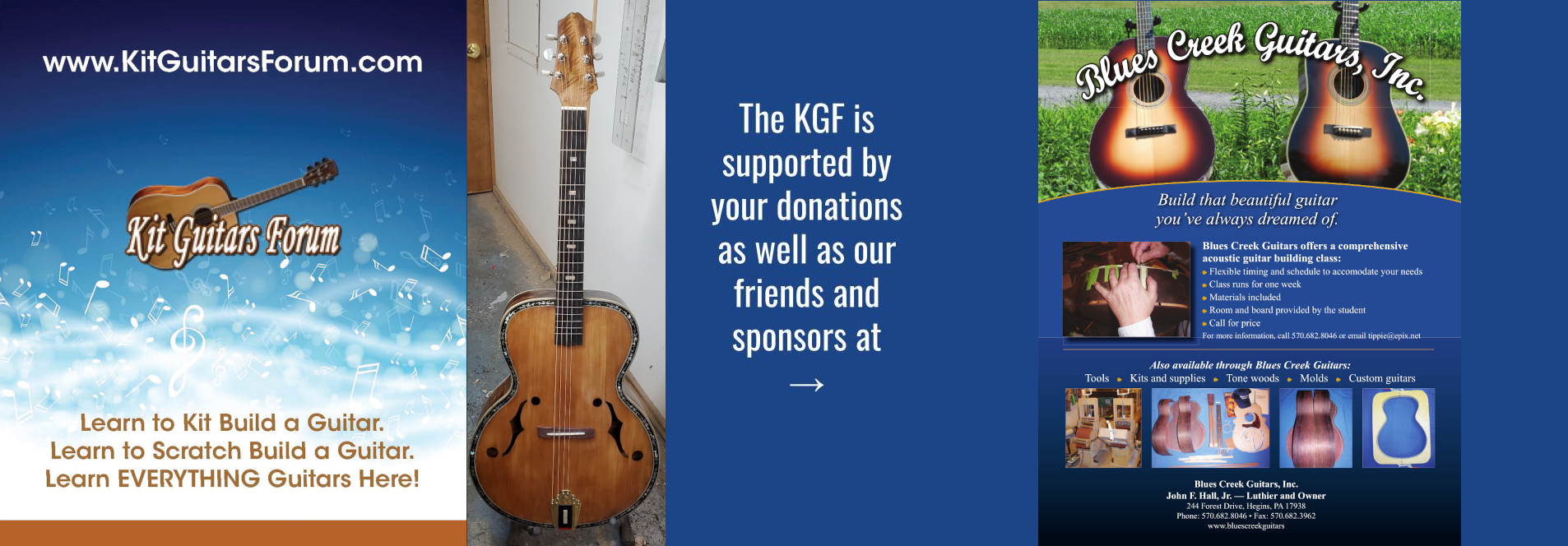Dreadnought comparison
-
Stray Feathers
- Posts: 766
- Joined: Sun Sep 08, 2013 11:39 pm
- Location: Ladysmith, BC
Dreadnought comparison
A year or so ago I finished a Sitka Spruce/East Indian Rosewood HD-28 copy (mostly) with scalloped bracing. I followed that with an Australian Blackwood dreadnought with tapered parabolic bracing. The rosewood guitar is more bassy, and the blackwood guitar is more balanced. I was interested to know how a rosewood guitar with tapered bracing would compare with the others. I made a bearclaw Sitka Spruce top to use as a demonstration item at an arts event I was in, and decided to incorporate tapered bracing, and that was the start of this comparison project (guitar number 10). It was put aside for a time but I am now back working on it. It's all braced and pretty conventional and I just have to glue the top down. One slight difference is that I used rosewood for the side strips, a little less noticeable. But I did wonder about how reliable it is to glue rosewood to rosewood (with Titebond 1). I'll see. The rosewood is one of a number of sets a friend and I got from the estate of the luthier Ted Thompson. The bridge plate is Purpleheart, which I read here somewhere is a good choice. Otherwise this guitar will be as much like the other rosewood dreadnought as I can make it from different billets of tonewood. I now have to sand and buff a Yamaki restoration and will then get back to this. Bruce W.
You do not have the required permissions to view the files attached to this post.
-
phavriluk
- Posts: 630
- Joined: Mon Jul 09, 2012 9:49 pm
Re: Dreadnought comparison
I think that any comparison of two dissimilarly-braced instruments that comments on the comparative tonal qualities of the back-and-side woods as being relevant to 'tone' is not useful. Bracing is way more predictive than lumber choices.
peter havriluk
-
Stray Feathers
- Posts: 766
- Joined: Sun Sep 08, 2013 11:39 pm
- Location: Ladysmith, BC
Re: Dreadnought comparison
I agree. My goal with this guitar was to have two Sitka/Rosewood dreadnoughts, braced differently, to see how the bracing affects the sound, and also to have two tapered-parabolic-braced dreadnoughts made of different tonewoods, to see how the woods affect the sound.
-
sylvan
- Posts: 108
- Joined: Mon Oct 08, 2012 3:55 pm
- Location: Ormond Beach, FL
- Contact:
Re: Dreadnought comparison
Richard Schneider, a wonderful luthier who worked with Michael Kasha in designing Kasha style bracing, told me, when I was a very inexperienced guitar maker, that making changes in a design of an instrument you would have to change at least 20% of the design to hear any difference. After 30 years of doing this I am convinced he was/is right. Making minor changes in bracing will make no hearable difference!
Sylvan Wells
Wells Guitars
Bay State Guitars
http://www.wellsguitars.com
http://www.baystateguitars.com
Wells Guitars
Bay State Guitars
http://www.wellsguitars.com
http://www.baystateguitars.com
-
Stray Feathers
- Posts: 766
- Joined: Sun Sep 08, 2013 11:39 pm
- Location: Ladysmith, BC
Re: Dreadnought comparison
That's an interesting observation, Sylvan. I have often wondered how people can discern a difference between guitars with "forward-shifted" vs normal bracing, for example. I'll see what happens with this comparison test. Maybe just another guitar?
Bruce W.
Bruce W.
-
phavriluk
- Posts: 630
- Joined: Mon Jul 09, 2012 9:49 pm
Re: Dreadnought comparison
People hear what they want to hear. How could a discerning critic not hear the tonal differences wrought by moving the braces around a half-inch? That critic would need to lock away the corks he/she was sniffing.Stray Feathers wrote: ↑Sat Dec 14, 2024 12:09 am That's an interesting observation, Sylvan. I have often wondered how people can discern a difference between guitars with "forward-shifted" vs normal bracing, for example. I'll see what happens with this comparison test. Maybe just another guitar?
Bruce W.
peter havriluk
-
rcnewcomb
- Posts: 393
- Joined: Wed Jul 29, 2015 9:04 pm
- Location: San Jose, CA, USA
Re: Dreadnought comparison
So true. I remember reading a long, heated discussion on a banjo forum. People were arguing that the wood used on the fingerboard of a banjo made a significant tonal difference, and had divided themselves into a rosewood camp, and an ebony camp.People hear what they want to hear.
In the 1970s I worked at a music store that kept 30 to 40 new Martins in stock with 5 or 6 of the main models in demand at the time: D18, D28, D35. There was variance in the instruments even within the same model. Every instrument found a home because the player chose the instrument that "felt" right for their style of playing.
- Randall Newcomb
10 fingers in, 10 fingers out - another good day in the shop
10 fingers in, 10 fingers out - another good day in the shop
-
Stray Feathers
- Posts: 766
- Joined: Sun Sep 08, 2013 11:39 pm
- Location: Ladysmith, BC
Re: Dreadnought comparison
Months later, I have finished putting this dreadnought together, and it is in the finishing process (spraying lacquer outside in favourable weather).The bearclaw figure is beginning to show more in the Sitka top. I'm finishing two ukuleles at the same time, for two shows coming up. Bruce W.
You do not have the required permissions to view the files attached to this post.

